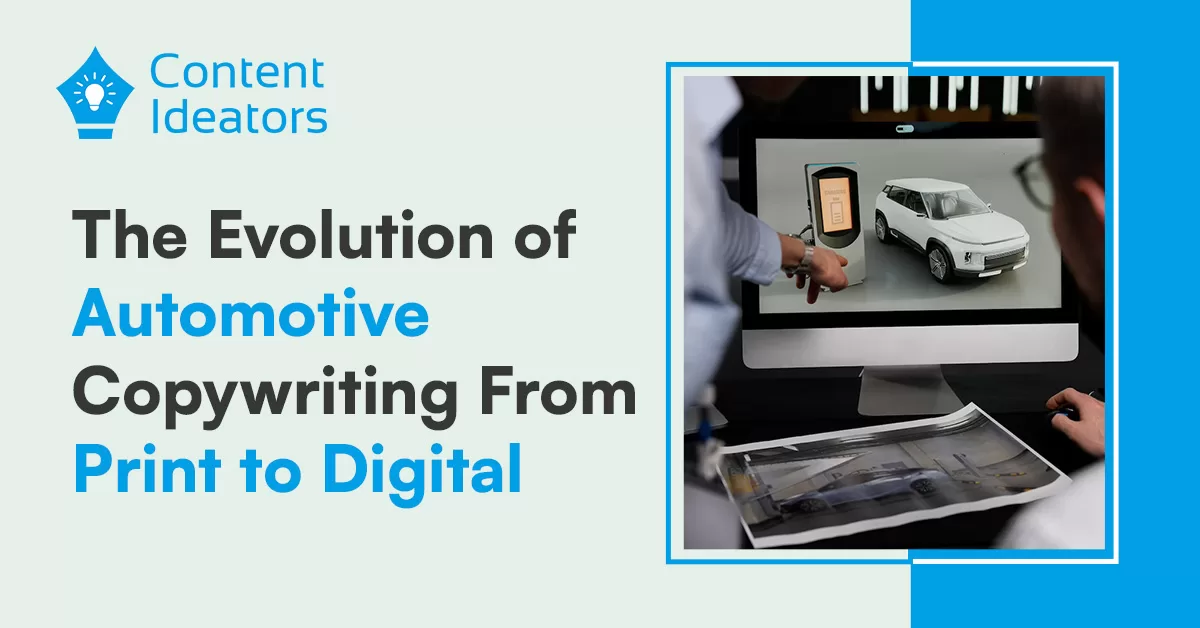The Evolution of Automotive Copywriting: From Print to Digital
 September 23, 2024
September 23, 2024Have you ever wondered how car manufacturers and dealerships market their products to consumers? They use automotive content ideas that have changed over the years in the transition from print to digital media. With the evolution of the internet, traditional print advertisements have become less effective.
Automotive copywriting is a specialized form of automotive content writing that uses words to persuade customers to act positively. Moreover, it has become one of the crucial advertising mediums for the automotive industry over the years, evolving from printed ads in daily newspapers to product brochures in the digital realm.
It has been a fascinating journey for automotive content creators with new technologies and marketing strategies. This blog explores the history of copywriting, its evolution, and its prospects for the automotive industry.
History of Automotive Copywriting
Over centuries, the automotive industry relied on advertising to connect with customers. Additionally, with constant growth in the industry, digital copywriting agencies are evolving everywhere, creating compelling content to provide customer satisfaction. Let’s delve into the history and evolution of automotive copywriting.
- Early History of Automotive Advertising in Print Media
The emergence of the automobile industry paved the way for new marketing strategies and advertising techniques for some notable campaigns and slogans. One of the earliest campaigns to gain national interest was John Emory Powers’ advertisement for Olds Motor Works in the late 1800s.
It featured the line “Prepare to be astounded,” which emphasizes the power of Olds Motor Works’ cars. It helped in setting the tone for future automotive advertising. The advertising challenges continued to grow in the industry. Print ads require a balance between providing technical product details and a call to action for potential customers. Copywriting agencies and freelance copywriters became a crucial element of the advertising industry.
One of the notable examples of slogan advertising is Henry Ford’s “Ford, the Universal Car” campaign. It emphasizes the affordability and accessibility of Ford’s cars. It highlighted the importance of high-quality content and effective writing in advertising strategies.
- The Transition to Digital Advertising
The automotive industry has seen changes in advertising practices over the years with the rise in digital advertisement. Print advertising, the loudest noise of that era, was slowly replaced by copywriting and advertising focused on digital platforms. It brought unique opportunities for automotive content writers and copywriters.
The creation of the internet’s first banner ad in 1994 marked the evolution of advertising. It created a medium through which advertisers can target potential customers. Companies started reaching larger audiences, which made it an exciting new approach to marketing.
Apple’s “Get a Mac” campaign is another example of a successful transition to digital advertising. It persuades consumers to buy Apple computers. The advertisements started with TV ads, print ads, and billboards demonstrating the potential of digital advertising. It generated 42% of market growth alone in the first year. However, the shift from print to digital advertising came with challenges.
There needed to be more digital space with so many competitors competing for their space. Moreover, SEO is crucial to make automotive content visible and valuable for potential customers. It also evolved interactive videos and well-crafted automotive social media content to grab audiences’ attention. Social advertising is now a $17 billion industry comprising 12% of brands’ annual marketing.
- Growth of the Automotive Industry and Digital Automotive Copywriting
The automotive industry significantly contributed to the global economy with its digital presence. It started meeting the demands of a highly competitive market and communicating with potential customers. Businesses started adapting their marketing strategies to include a robust digital presence.
It is vital for the automotive industry, where customers compare and research vehicles online before purchasing. Additionally, Digital automotive copywriting helps businesses to reach potential customers and to provide quality information about their products or services.
It allowed businesses to focus less on tactics such as newspapers and instead on search engine optimization. Copywriters have learned to master the English language and understand the needs of their target audience. They use customer experience and calls to action to encourage positive actions, standing out from the noise through high-quality content. These strategies help to increase traffic and drive conversions, leading to more advertising dollars for businesses.
Basics of Good Automotive Copywriting
Good automotive copywriting requires compiling automotive content ideas, skills, and techniques that engage, inform, and excite potential customers. Combining these elements allows you to create compelling content that drives positive actions and enhances the customer experience. Promotional items featuring a company’s logo can boost brand recall by up to 85% among recipients.
- Crafting Impactful Headlines and Introductions
A headline and introduction are the first things a potential reader sees as they convey the main idea of the content. Automotive copywriters look for a powerful headline that makes a customer decide to read on or scroll past.
It should be clear and concise while conveying the content. Try using solid adjectives and action verbs to make the headline more attractive to readers. Then, introductions attract the readers and keep them engaged.
It creates interest, sparks curiosity, and provides value to the reader. Insert striking statistics or anecdotes or ask questions to encourage readers to read more. Moreover, avoid common mistakes, such as clickbait or misleading claims.
- Developing a Clear Message That Resonates with Consumers
Start with describing the client’s persona, including information such as age, occupation, interests, and hobbies. Explaining how your product or service can offer a solution or transformation to the audience’s needs is crucial. Focus on the advantages of your product or service clearly and concisely. Avoid jargon and complex technical terms that may alienate potential customers.
- Creating Compelling Visuals that Enhance Your Writing
Copywriters use high-quality images and graphics to enhance content quality. The visual elements align with the context and tone to complement your message. Infographics and charts are potent tools to represent complex data and information in an accessible format visually. Moreover, introducing visual elements at just the right point in your automobile content writing can help in highlighting key points or break up the long text.
- Leverage SEO for Maximum Reach and Effectiveness
Automotive copywriters use SEO to use keywords strategically and naturally throughout the content. They maintain an equal keyword density to make it rank high for search engines. To leverage SEO, marketers, and copywriting agencies adopt a multi-pronged approach.
They incorporate relevant keywords, using meta tags, headings, and subheadings, and improving the content of linked pages. Therefore, it boosts organic traffic of your website, making your content more visible to potential customers.
Wrapping up
In conclusion, effective automobile content writing is crucial for promoting products and services in the fast-paced and ever-evolving automotive industry. The key takeaways from this blog provide a solid foundation for anyone looking to enhance their copywriting skills and achieve greater customer engagement and retention. However, exercising ethical conduct and avoiding deceptive practices is essential to build customer trust. Here’s to effective automotive writing!

